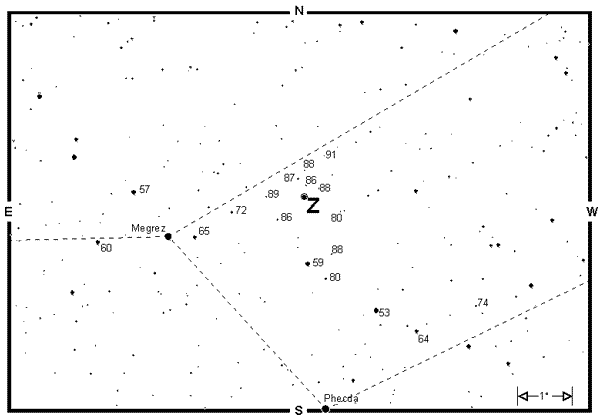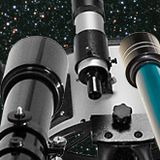
Before the invention of the telescope, our ancestors marveled at the permanent nature of the stars at night. Planets, the Sun, and Moon moved, and comets occasionally appeared in the sky, then faded, but the stars remained constant and fixed to the celestial sphere. They were considered a source of great stability in an otherwise unstable world. At least, most were. There were exceptions.
Even in ancient times, some rogue stars were known to misbehave and were regarded with awe and fear. One such star was located in the constellation Cetus, the Whale. At times, it could be seen easily with the unaided eye, while at others, it was only dimly visible, if at all. Early skywatchers named this star Mira, which means "wonderful." Then, there was the case of the Demon star, Algol, marking the evil eye of Medusa's decapitated head in the constellation Perseus (hey, nobody said constellation mythology was pretty!). Algol winked at stargazers, varying from dim to bright over the course of about three days. What could be causing these amazing sights?
Once the telescope was turned to the heavens, astronomers began to discover more stars that changed in brightness like Algol and Mira. Today, thousands of these so-called variable stars are known and cataloged. Some fluctuate in brightness by only a few tenths of a magnitude, while others may vary by five or ten full magnitudes, or even more!
For amateur astronomers, observing variable stars can be an interesting and challenging pursuit, a different twist on typical stargazing. Before we get into the how-to of observing them, let's review the different kinds of variable stars.
Pulsating, Erupting, Eclipsing — They Vary
Variable stars like Mira are classified as pulsating variables. Known to be old, red giant stars, they actually expand and contract in diameter like a beating heart. Their rhythmic pulsations usually take weeks or months to complete a cycle.
A second class of variable stars suddenly and unpredictably change in brightness in just a few days, hours, even minutes, and so, are called eruptive variables. One example of an eruptive variable star is a nova. Here, a white dwarf star lying close to a normal star abruptly increases in brightness by five or more magnitudes, only to fade slowly back to its original, pre-eruption brightness over the course of several weeks. Another example of an eruptive variable are called R Coronae Borealis stars. These peculiar suns actually drop in brightness due to the formation of clouds of "soot" in their atmospheres.
Algol represents a third class of variable stars called eclipsing binaries. In these cases, the stars themselves do not fluctuate in brightness, but instead, are alternately covered and uncovered by unseen, orbiting companions. When a companion passes in front of or behind the system's primary star, their combined brightness fades, only to return after the eclipse ends. By measuring the period and amplitude of the fluctuations, astronomers can tell how far the two stars are apart and how long the companion takes to orbit. In the case of Algol, the orbital period is 2 days 20 hours 49 minutes, with the two stars separated in space by about 10 million kilometers (about 6 million miles).
How Bright is That Variable?
It?s fun to estimate the apparent magnitude of variable stars. This is usually done by comparing their brightness with that of neighboring stars of known (and fixed) brightness. The American Association of Variable Star Observers (AAVSO) has a collection of special finder charts for variable stars, which give the magnitudes of surrounding stars. The variable may appear to be the same brightness as one of the reference stars, which makes estimating its magnitude easy. Or, if the variable is brighter than comparison star A, but dimmer than comparison star B, then the variable?s magnitude lies somewhere in between. If star A is magnitude 8.0 and star B is 8.8, then the variable star may be about magnitude 8.4. This is called interpolation.
See the "Z": Check Out this Big Dipper Variable
Here?s a variable star that has long been a favorite among variable star observers. Z Ursae Majoris is categorized as a red, pulsating star, fluctuating between magnitudes 6.5 and 9.4 over a period of 195 days. What makes Z such a favorite is its location inside the bowl of the Big Dipper, about 2.5 degrees to the west-northwest of Megrez, the star that joins the bowl to its handle. This northerly location also means that the star stays above the horizon year-round for many observers in the Northern Hemisphere.
You don?t need fancy equipment to make accurate estimates of the brightness of variable stars — just your eye! It's really not as hard as it might sound at first. Begin by locating the star right in the center of the chart below, labeled with a "Z."

Some of the stars on the chart are numbered, while others are not. Those numbers represent the magnitudes of those stars. The decimal point has been omitted, since it would be easy to confuse it for another star. The star labeled "72" is really magnitude 7.2, while the star marked "86" shines at magnitude 8.6, and so on. These fixed-brightness "comparison stars" can be used to estimate the brightness of the variable.
If it's clear tonight, bring a print of the chart outside and find Z through your telescope or binoculars (you won?t be able to see it with your naked eyes). Begin at Megrez, then shift slowly north and west, following the trail of stars to its position (see "Star-Hopping: How and Why" for more details about locating sky objects). Be sure to use a low-power eyepiece to show the widest field of view. Unless it happens to be near its minimum brightness, Z should be bright enough to be seen through most finder scopes and binoculars.
With Z in view, take a look around at the stars in the eyepiece and compare them with the stars on the chart. Rotate the chart around so that the stars' orientation matches the eyepiece view. Remember, if you are using a star diagonal in your telescope, the view will be flipped left-to-right, like a mirror.
Begin by locating the variable star through your binoculars or telescope. Any type of telescope can be used, but be sure to select just enough magnification to see the star. Low power is usually preferred, since higher powers have very restrictive fields of view. Take a look around and find some of the comparison stars. Look for one or two that appear a little brighter than the variable, and one or two that are a little dimmer, then estimate how much brighter or dimmer the variable is from the others. For instance, you may find that Z appears a little dimmer than the "80" and "83" stars, but brighter than the "86" and "87" stars. If so, the variable must be either magnitude 8.4 or 8.5. Narrow your view now and scan back and forth between Z and the "83" and "86" stars. Try to decide if the variable is a little closer to one of the other, and mark down your estimate.
By keeping track of your estimates over the course of weeks or months, you will be able to plot a "light curve," a plot of the stars changing brightness over time. Mark the passage of time in days along the "X" axis (horizontal) and brightness along the "Y" axis (vertical). Plot the points matching the intervals of days and your magnitude estimates, then connect the dots. You?ve created a light curve just as professional astronomers do when studying variable stars!
Interested in viewing more variable stars? Here is a short sampling of the sky's most interesting ones.
| Star | Constell. | RA | Dec | Mag | Per. | Type |
|---|---|---|---|---|---|---|
| Spring | ||||||
| R Coronae Borealis | Corona Borealis | 15 48.6 | +28 09 | 5.8 to 14.8 | Irreg. | Eruptive |
| R Leonis | Leo | 09 47.5 | +11 26 | 5.8 to 10.0 | 313 | Pulsating |
| R Virginis | Virgo | 12 38.5 | +06 59 | 6.0 to 12.1 | 146 | Pulsating |
| Z Ursae Majoris | Ursa Major | 11 56.5 | +57 52 | 6.5 to 9.4 | 195 | Pulsating |
| Summer | ||||||
| Chi Cygni | Cygnus | 19 50.6 | +32 55 | 3.3 to 14.2 | 407 | Pulsating |
| RT Cygni | Cygnus | 19 43 | +48 46 | 6.0 to 13.1 | 190 | Pulsating |
| Beta Lyrae | Lyra | 18 50.1 | +33 22 | 3.4 to 4.3 | 12.94 | Eclipsing |
| R Scuti | Scutum | 18 47.5 | -05 42 | 5.0 to 7.0 | 144 | Pulsating |
| Autumn | ||||||
| R Andromedae | Andromeda | 00 24.0 | +38 35 | 5.8 to 14.9 | 409 | Pulsating |
| Delta Cephei | Cepheus | 22 29.2 | +58 25 | 3.5 to 4.4 | 5.37 | Pulsating |
| Mira | Cetus | 02 29.3 | -02 59 | 3.4 to 9.2 | 332 | Pulsating |
| Winter | ||||||
| R Leporis | Lepus | 04 59.6 | -14 48 | 5.5 to 11.7 | 432 | Pulsating |
| Algol | Perseus | 03 08.3 | +40 57 | 2.1 to 3.3 | 2.87 | Eclipsing |
Notes:
Mag is the variable's range in brightness.
Per. is short for Period, the number of days it takes the variable to complete a full period, or cycle, in brightness
Amateur observations of variable stars are especially sought by professional astronomers worldwide. If you are interested in learning more about observing variable stars, or in obtaining a set of variable star charts, contact the American Association of Variable Star Observers at 25 Birch Street, Cambridge, Massachusetts 02178, or visit their Web site at http://www.aavso.org.






















